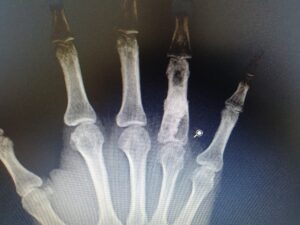A tumour is a swelling of the hand due to an abnormal growth of tissue. Tumours are of two varieties. Benign tumours are harmless growths. They will not cause any harm if left untreated. Malignant tumours can sometimes be a threat to our health if not addressed in time. Fortunately, many malignant tumours of the hand do not behave aggressively, like other parts of the body where they can spread rapidly and endanger life.
Symptoms
Common symptoms of benign hand tumours include a painless slowly progressive swelling while malignant tumours can be painful and more rapidly progressive. The tumour may only cause cosmetic concerns or can cause functional problems depending on the nearby structure which it is affecting. If it is stretching or compressing a nerve it may cause numbness and tingling sensation or weakness in the region the nerve supplies. If it is near a joint or stretching or compressing a tendon it can cause restriction of that joint movement. If it is stretching or compressing a blood vessel it can cause exertion related or environmental temperature related pain.




Causes
Exact causes of many tumours are not known. However certain factors increase the risk of developing tumours. They may be genetic factors, repetitive motion of hand and wrists, hormonal imbalance, and other medical conditions such as hypothyroidism, rheumatoid arthritis, diabetes, obesity, gout, overactive pituitary gland, or the presence of an abnormal structure by birth.




Conservative Treatment Options
Tumours may be treated using conservative approaches or surgery. The conservative treatments include:
- Treating underlying medical conditions
- Immobilisation of the hand and wrist with a splint or wrist brace for 4-6 weeks
- Rest the hand
- Avoid activities that tend to worsen the symptoms
- Medications such as non-steroidal anti-inflammatory drugs
- Strengthening and stretching exercises once symptoms diminish


Surgery
If conservative treatment options fail to resolve the condition or if the tumour is suspected to be malignant Dr Bala may recommend a surgical procedure.




Tumour Surgery
Tumours can be treated with tumour excision biopsy if benign or wide local or radical excision depending on the spread if it is malignant. During the surgery, the tumour will be dissected to release the pressure on the surrounding structures. Dr Bala will decide which options are best for you based on your general and medical conditions.
He prefers general anaesthesia over local anaesthesia for faster recovery and to better visualise important structures to protect.


Post-Operative Care
Dr Bala may suggest you practice certain post-operative procedures for better recovery and to avoid further complications.
- Elevate the hand above heart level to reduce swelling.
- Ice packs to the surgical area to reduce swelling.
- Keep the surgical incision clean and dry. Cover the area with plastic wrap when bathing or showering.
- Physiotherapy may be ordered to restore wrist strength.
- Eating a healthy diet and not smoking will promote healing
Risks and Complications
Most patients suffer no complications from tumour surgery. However, in rare cases a patient may suffer from pain, infections, scarring, and nerve damage causing weakness, paralysis, or loss of sensation and stiffness in the hand and wrist area. Recurrence is always a concern with malignant tumours.
Dr Bala uses special magnification loupes to visualize and protect structures to minimize complications. In the event you may have a tattoo on the wrist or hand Dr Bala is well versed in suturing tattoos back accurately with absorbable sutures.
Dr bala has created an instructional video on finger Giant Cell tumour excision which maybe accessed here
https://www.vumedi.com/video/finger-gct-excision/
